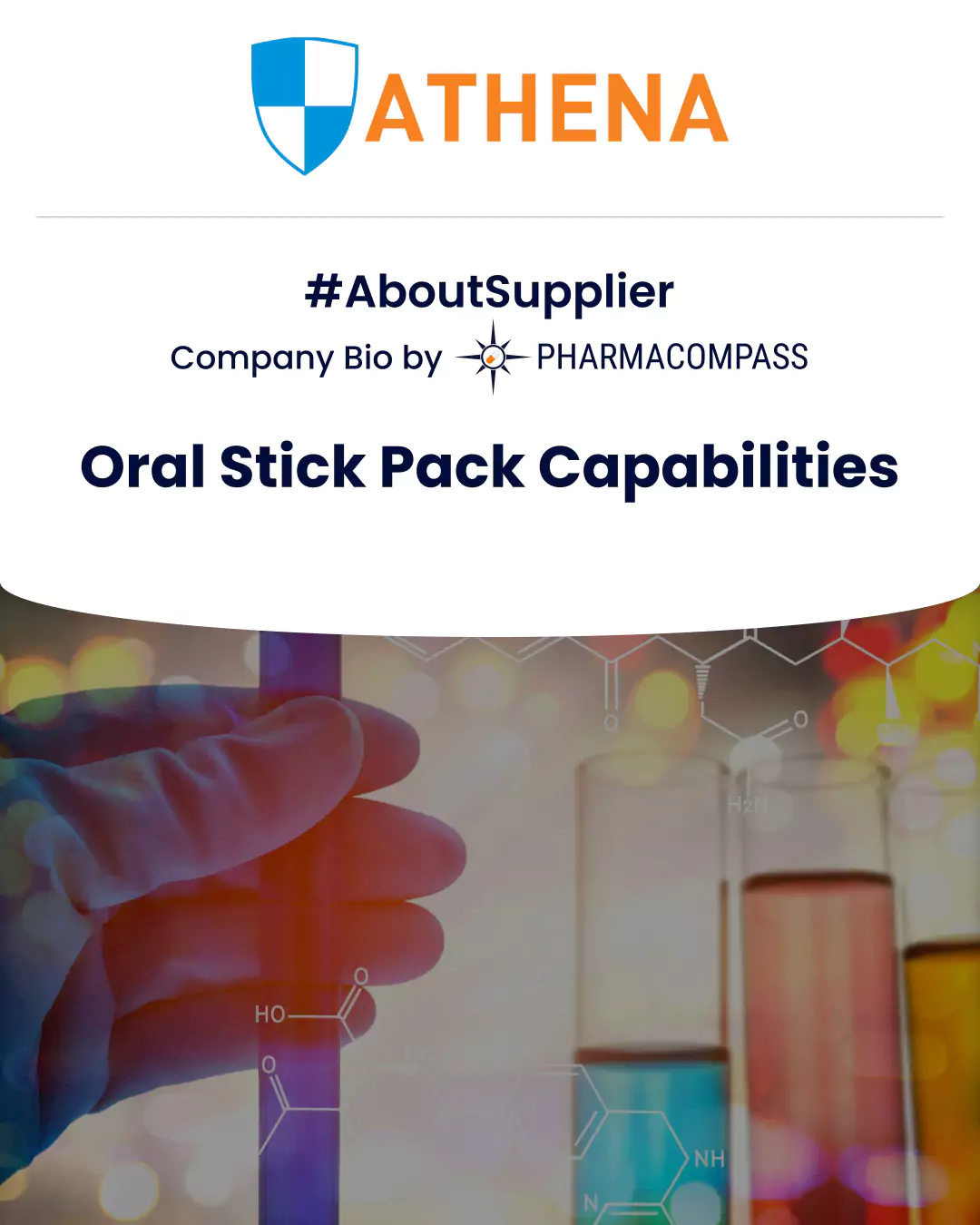
By PharmaCompass
2021-10-12
Impressions: 1484
Overview of stick-packs including liquid & powder oral sticks, contract packaging & more on Athena, a CDMO for stick packs, on PharmaCompass.
Q1. What are stick packs and what are the benefits?
Stick packs are single-dose or unit-dose packaging configurations that are becoming increasingly popular for virtually any application. A stick-pack is partially defined by its shape: it looks like a stick or a tube, having a long, slender configuration. Individual packs, such as sachets and stick packs, are universally convenient.
The single dose stick-pack is an increasingly successful format due to its practicality. The food, pharmaceutical, cosmetic and even the home cleaning sectors demand this solution to cater to the high demand from consumers.
In the pharmaceutical industry stick-packs can be used as primary packaging solutions for liquids, powders, syrups, granules, etc. to create user-friendly dosage forms (eg. user-friendly oral dosage forms).
The defining name stems from the format’s relative size and shape as compared to traditional pouches, which are flat/rectangular in footprint and sealed on three or four sides.
Each stick pack is unique and reflects the personality of the brand and the product. Therefore, it knows no limitations with the possibility of choosing the width and height of the package and at the design level, it can print a large number of inks, have metallized finishes, transparencies, etc.
Some Benefits of Stick-Packs
- A stick pack allows sensitive Active Pharmaceutical Ingredients (APIs) to be safely stored and protected until the point of use.
- The single dose stick-pack is a pre-dosed drug delivery system. With this, the patient or caregiver is certain of the dose being administered and it curbs the misuse of medications.
- Stick packs are user-friendly dosage forms that increase patient compliance due to its convenient nature, portability and the possibility of taste masking.
- Stick packs offer the benefit of increased marketability due to unique packaging and labelling options, which differentiate one brand from another.
- Stick packs result in reduced costs as many processes required for making conventional dosage forms and complex formulations are bypassed.
- A single dose stick-pack conveniently holds a single serving of finished products, so it is compact and portable which makes it attractive to consumers with active lifestyles.
Q2. What are the different types of oral stick packs?
Dosage forms are the means by which drugs containing Active Pharmaceutical Ingredients (APIs) are delivered to specific sites of action within the body to elicit a therapeutic reaction. Specialized Dosage forms can be classified according to their routes of administration, with the oral drug delivery system being the most common.
Furthermore, dosage forms may be classified on the bases of their physical properties into liquid dosage forms, solid dosage forms, and semi-solid specialized dosage forms. Oral formulations are available in all three pharmaceutical forms and may be packaged in stick-packs.
Types of Oral Stick Packs
- Liquid Stick-Packs
Liquid Stick packs are the new trend in single-dose drinkable products that are ideal for small and medium doses. Liquid stick packs may contain solutions, suspensions or emulsions. Liquid stick packs reduce medication dosage errors while appealing to a consumer’s desire for convenience with a stick-pack alternative to plastic bottles with measuring cups.
A liquid stick-pack oral dose delivers a precise dosage that is suitable for populations with swallowing difficulties (children and seniors), as well as patients with an active lifestyle, thanks to its ease of administration (taken without water).
- Stick Packs for Solid Oral Forms
Solid oral forms consist of tablets, coated tablets, capsules, effervescent tablets, Oral Disintegrating Tablets (ODT), pellets, granules and powders. Traditionally, the last three are packaged in sachets (sealed-edge pouches) or, since mid-2000, in the innovative packaging form called stick packs.
Hermetic stick packs and sachets are the optimal packaging solution for single-dose powder finished products. Stick-packs increase patient compliance for powders, granules and other formulations. Furthermore, it ensures precise dosing which may be hard to achieve otherwise.
- Powder Stick Packs: Powder stick-packs contain dry powder oral formulations. They serve as alternatives to drugs in capsules, tablets and sachets. Powder stick-pack oral dose formulations are easy for patients to carry and use and can be taken directly or be diluted in food or drinks. Furthermore, powder stick packs act as novel substitutes for patients with swallowing difficulties.
- Stick Packs for Semi-solids
Stick packs are also available for semi-solid finished products including creams, lotions, gels, etc. This kind of packaging has an environmentally soft footprint that appeals to many brands and consumers because it uses far less materials than most other kinds of packaging. Due to the narrow tipped, tubular configuration, spillage is less likely than with other package types.
Q3. How is stick-pack filling and packaging achieved?
Stick packs are a form of primary packaging which create user-friendly dosage forms. The operation of stick pack machines is very similar to more common, single lane vertical form-fill-seal packaging machines where a roll of film is cut and formed into single bags. Then, the bags are filled with product and sealed, all in a vertical fashion.
Steps for Stick-Pack Filling and Packaging for User-friendly Oral Dosage Forms:
Step 1: Film Transport & Unwind
First, the stick packing machine begins by relaying and unwinding the film that will hold the products. The machine uses a single sheet of film material that rolls around a rolling stock which is kept in motion via a cross-seal jaw.
Step 2: Film Tension
In the next stage, as the film reel unwinds it passes over a dancer arm at the rear-end of the machine. The arm has a series of nip rollers which apply even pressure to the films in order to maintain constant tension, thereby ensuring that the weighted-pivot arm is in the proper position at all times.
- Optional Step: Printing
Printing is an optional process during stick-pack packaging. Often stick pack clients desire to print expiration dates or lot codes on their stick packaging. A stamping device with the required information can be fed around a registration roller, which helps achieve desired positioning of the label.
Step 3: Film Cutting
After leaving the nip roller section, the film, which is still under tension, is cut by a set of blades or knives according to required dimensions, thus forming several rows. The number of rows depends on the number of tracks of the stick-packaging machine used. These strips form the basis for the individual stick packs.
Step 4: Stick Pack Forming
The strips then pass over a forming assembly. First a vertical seal assembly bonds the two sides of the strips together, creating a vertical seam on the bag. Next, the tubes enter the cross seal assembly to receive their horizontal seal.
Step 5: Stick Pack Filling and Sealing
While the sealing jaws are closed, the finished product that is being packaged is dropped down the center of the forming tubes to fill each individual bag. A filling apparatus like a volumetric filler, liquid pump, or auger filler is responsible for the correct measurement and release of discrete quantities of the product to be dropped into each stick. Stick pack filling is conducted on a stick-pack filling line.
Once the stick pack is filled, it continues down to the knife cutting station. Each individual lane is fitted with a sharp cutting knife that seals and separates each stick pack from the one above it.
Step 6: Stick Pack Discharge
Finally the individual filled and sealed stick pack is released via an outfeed chute. After the entire stick-pack filling and packaging process is complete the individual stick packs may be subject to quality checks and may undergo secondary packaging. Secondary packaging may use case packaging or carton packaging equipment.
An integrated CDMO for stick packs which has stick-pack unit-dose packaging capabilities can offer pharmaceutical packaging services such as stick-pack filling for user-friendly oral dosage forms. CDMO for stick packs and the contract services they offer are explored in detail in the subsequent question.
Q4. What contract packaging services does a CDMO for stick packs such as Athena offer?
A Contract Development and Manufacturing Organization (CDMO) serves the pharmaceutical industry by enabling the option of outsourcing formulation development and manufacturing services.
It provides clients with comprehensive specialized services either for Active Pharmaceutical Ingredients (APIs) or finished dosage forms (non-sterile and sterile complex formulations), or both. The services range from pharmaceutical development through to manufacture, scale-up and at times may include integrated contract packaging services.
Services offered by an integrated, specialist CDMO may include, but are not limited to: pharmaceutical development, formulation development, clinical trial materials, scale-up, full commercial manufacturing, primary packaging and secondary packaging (ie. integrated contract pharmaceutical packaging services), etc.
A specialist CDMO for stick packs offers various specialized services for the integrated contract pharmaceutical packaging of stick packs. These specialized services may include stick-pack unit-dose packaging capabilities such as primary packaging, secondary contract packaging services, stick-pack filling, etc.
Athena Pharmaceutiques is a specialist CDMO for oral formulations. It is focused on innovative and value-added products in mature and emerging markets and is engaged in licensing and pharmaceutical development models for specialty pharma, multinationals and other established companies.
The French based company with existing full commercial manufacturing and R&D operations in India announced the acquisition of the manufacturing factory Inpharmasci in 2020. Inpharmasci is an EU GMP approved facility specialised in the full commercial manufacturing and scale-up of solid oral forms, including Oral Disintegrating Tablets (ODT) and effervescent tablets, for specialty and generic clients in Europe with a French focus.
Its other manufacturing plant Athena Drug Delivery System (Athena DDS) situated in Mumbai, India is also equipped with state of the art technology for oral solids. It offers outsourcing formulation development and manufacturing services for oral formulations.
Their Indian and French facilities can handle a vast majority of specialized dosage forms like bilayer tablets, capsules, sachets and stick packs, effervescent tablets, Oral Disintegrating Tablets (ODT), oral solids and conventional dosage forms.
Athena Inpharmasci (Athena IPS) specialises in dry pharmaceutical forms and the manufacturing of uncoated, coated and sugar coated tablets, stick pack oral dose, capsules, and pills. Athena’s Inpharmasci site thus has stick-pack unit-dose packaging capabilities and functions as a CDMO for stick packs by offering contract pharmaceutical packaging of dry pharmaceutical forms in oral stick packs.
The PharmaCompass Newsletter – Sign Up, Stay Ahead
Feedback, help us to improve. Click here
Image Credit : Biosynthesis, tech advancements by PharmaCompass is licensed under CC BY 2.0
“ The article is based on the information available in public and which the author believes to be true. The author is not disseminating any information, which the author believes or knows, is confidential or in conflict with the privacy of any person. The views expressed or information supplied through this article is mere opinion and observation of the author. The author does not intend to defame, insult or, cause loss or damage to anyone, in any manner, through this article.”







